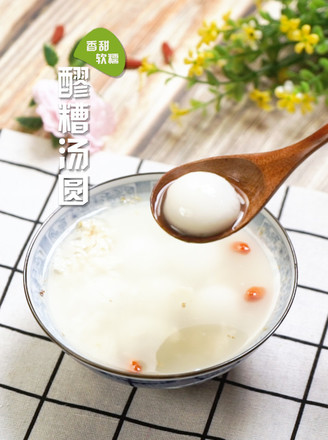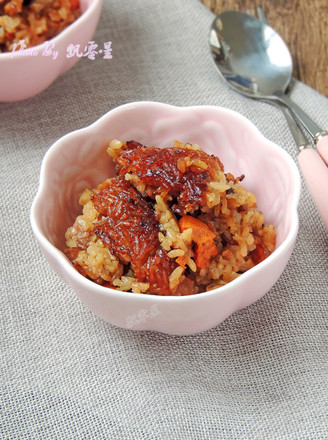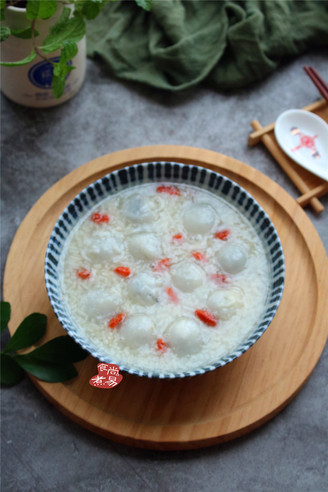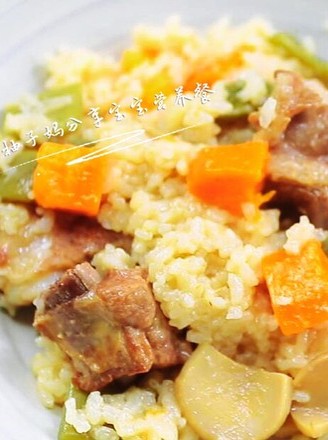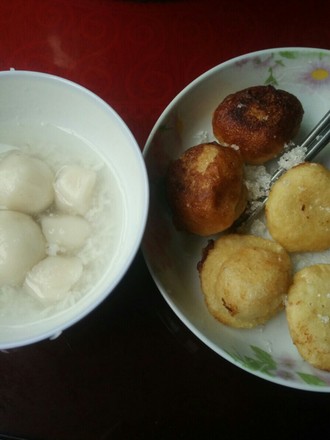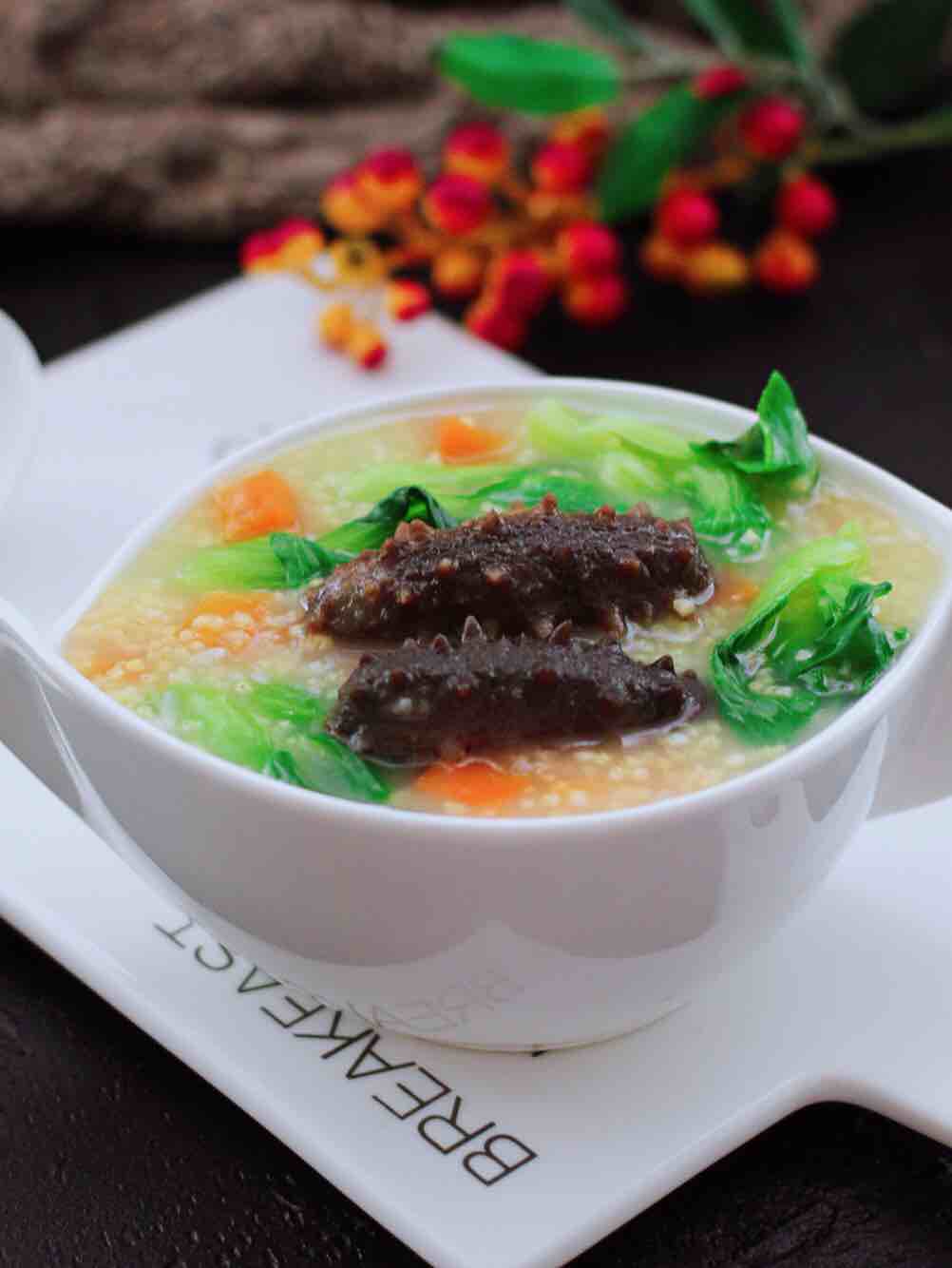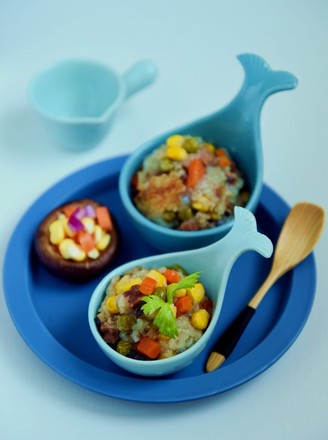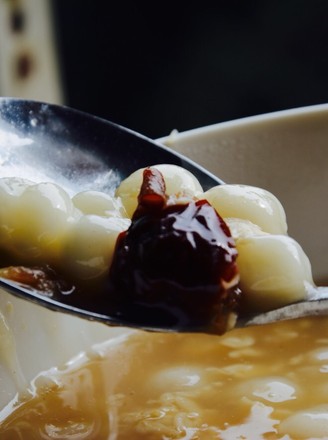[mung Bean and Coix Seed Fermented Rice]: Using A Bread Machine to Make Fermented Fermented Rice
1.
Wash the glutinous rice in advance, add 2~3cm of water to the glutinous rice, soak for more than 4~5 hours, soak until the rice grains can be crushed by fingers. The specific time varies according to the weather. It can be soaked one night in advance in winter, and within half a day in summer, and it is best to put it in the refrigerator in summer;
2.
Drain the glutinous rice, put it in a container, and poke small holes on the surface;
3.
Put the container into the steamer, and continue to steam for about 30 minutes after the high heat is steamed;
4.
When steaming glutinous rice, take appropriate amount of koji;
5.
Crush the koji and put it in a bowl;
6.
After the glutinous rice is completely steamed, the rice grains become fat and transparent;
7.
Take out the steamed glutinous rice, scatter and let cool;
8.
Take most of the distiller's yeast, mix with an appropriate amount of cold water, and mix well. Remember not to use up all the koji powder, leave a little for later;
9.
Cool until the glutinous rice is not hot to your hands. When the temperature is less than 40 degrees, add the distiller's yeast liquid in batches, and stir the rice grains as you add them. After the koji liquid is added, continue to add the remaining cold white boil;
10.
It is best to mix the rice grains into a single grain;
11.
Put the mixed glutinous rice into the bread bucket of the bread machine and compact it slightly;
12.
Then dig a hole in the middle of the glutinous rice and put in the remaining part of the koji powder;
13.
Put the bread bucket in the bread machine and close the lid. Select "Menu 24": "Low-temperature fermentation and rice wine" function. The time required for the program will appear on the LCD screen and start blinking. The default time is 48 hours, but you can choose between 24 hours and 72 hours. I chose 48 hours. Then you can leave it alone;
14.
After the bread machine is finished, a warning tone will sound. Open the lid at this time, you can see that clear liquid has begun to appear in the dimples. At this time, take out the prepared rice wine and put it into a container that has been sterilized and dried. According to personal preference, add an appropriate amount of cold boiled water, seal it and put it in the refrigerator for storage.
15.
Soak mung beans and coix seed in advance. I used peeled mung beans this time;
16.
Add appropriate amount of water, cook mung beans and coix seed;
17.
Filter out the cooked mung beans and coix seed, take an appropriate amount into the container;
18.
Add an appropriate amount of fermented rice, and then add some fermented rice soup;
19.
Add appropriate amount of cold water according to personal taste, honey, ice cubes and so on. When eating, sprinkle some dried osmanthus and stir it yourself.

![[mung Bean and Coix Seed Fermented Rice]: Using A Bread Machine to Make Fermented Fermented Rice recipe [mung Bean and Coix Seed Fermented Rice]: Using A Bread Machine to Make Fermented Fermented Rice recipe](https://img.simplechinesefood.com/9a/9a5fc5e48343f431241d2f9464aa09f5.jpg)
Tips:
1. The glutinous rice should be soaked in advance, but don't soak for too long, or the steamed glutinous rice will be rotten, and the grains of fermented rice will not be obvious;
2. The glutinous rice must be steamed all at once. If it is not steamed, it cannot be steamed for the second time. Keep this in mind. If you are not sure, you can taste it after steaming;
3. When the glutinous rice is cold enough not to be hot, you can add the liquor. Because the distiller’s yeast is also cold, if the glutinous rice is too cold, the fermented rice will taste more sour. But if the temperature is too high, it will kill the koji;
4. It is best to mix the glutinous rice until the grains are separated. The fermented rice will be more distinct in this way;
5. When making rice wine, don't add too much cold water at the beginning. After the fermentation is complete, add an appropriate amount of cold water to mix;
6. In the process of making rice wine, the containers, tools, and hands used must be oil-free, and do not touch raw water;
7. The fermented rice wine can be stopped by adding cold boiled water and putting it in the refrigerator. The over-fermented rice wine will have a little bitter taste, and the rice grains will be empty and unpalatable.

![[mung Bean and Coix Seed Fermented Rice]: Using A Bread Machine to Make Fermented Fermented Rice [mung Bean and Coix Seed Fermented Rice]: Using A Bread Machine to Make Fermented Fermented Rice](https://img.simplechinesefood.com/2f/2f872dd321189dec8d5f801c66ac58cb.jpg)
![[mung Bean and Coix Seed Fermented Rice]: Using A Bread Machine to Make Fermented Fermented Rice recipe [mung Bean and Coix Seed Fermented Rice]: Using A Bread Machine to Make Fermented Fermented Rice recipe](https://img.simplechinesefood.com/b4/b46dcff6b9ca86eaa42cbf048e1e2c96.jpg)
![[mung Bean and Coix Seed Fermented Rice]: Using A Bread Machine to Make Fermented Fermented Rice recipe [mung Bean and Coix Seed Fermented Rice]: Using A Bread Machine to Make Fermented Fermented Rice recipe](https://img.simplechinesefood.com/4d/4dfe66d9aac22c5a9d9e574720ea4e8a.jpg)
![[mung Bean and Coix Seed Fermented Rice]: Using A Bread Machine to Make Fermented Fermented Rice recipe [mung Bean and Coix Seed Fermented Rice]: Using A Bread Machine to Make Fermented Fermented Rice recipe](https://img.simplechinesefood.com/38/38d458a7cbacde79e8dca5f4467c6853.jpg)
![[mung Bean and Coix Seed Fermented Rice]: Using A Bread Machine to Make Fermented Fermented Rice recipe [mung Bean and Coix Seed Fermented Rice]: Using A Bread Machine to Make Fermented Fermented Rice recipe](https://img.simplechinesefood.com/2b/2bb6f426e86da507b538144577d2febb.jpg)
![[mung Bean and Coix Seed Fermented Rice]: Using A Bread Machine to Make Fermented Fermented Rice recipe [mung Bean and Coix Seed Fermented Rice]: Using A Bread Machine to Make Fermented Fermented Rice recipe](https://img.simplechinesefood.com/1b/1bca172cffddb90c45c540c7449f4a68.jpg)
![[mung Bean and Coix Seed Fermented Rice]: Using A Bread Machine to Make Fermented Fermented Rice recipe [mung Bean and Coix Seed Fermented Rice]: Using A Bread Machine to Make Fermented Fermented Rice recipe](https://img.simplechinesefood.com/cb/cbc974bf10a70d3c755ec65091c99383.jpg)
![[mung Bean and Coix Seed Fermented Rice]: Using A Bread Machine to Make Fermented Fermented Rice recipe [mung Bean and Coix Seed Fermented Rice]: Using A Bread Machine to Make Fermented Fermented Rice recipe](https://img.simplechinesefood.com/eb/eb54ae6693afe55bd3ffc8efec620b76.jpg)
![[mung Bean and Coix Seed Fermented Rice]: Using A Bread Machine to Make Fermented Fermented Rice recipe [mung Bean and Coix Seed Fermented Rice]: Using A Bread Machine to Make Fermented Fermented Rice recipe](https://img.simplechinesefood.com/07/07bb288a2711047bc97871e50fdcee1e.jpg)
![[mung Bean and Coix Seed Fermented Rice]: Using A Bread Machine to Make Fermented Fermented Rice recipe [mung Bean and Coix Seed Fermented Rice]: Using A Bread Machine to Make Fermented Fermented Rice recipe](https://img.simplechinesefood.com/6c/6cc6afd6ca0d91b31aa118e037148130.jpg)
![[mung Bean and Coix Seed Fermented Rice]: Using A Bread Machine to Make Fermented Fermented Rice recipe [mung Bean and Coix Seed Fermented Rice]: Using A Bread Machine to Make Fermented Fermented Rice recipe](https://img.simplechinesefood.com/f1/f1d23764237a22c466c600c717ac5eba.jpg)
![[mung Bean and Coix Seed Fermented Rice]: Using A Bread Machine to Make Fermented Fermented Rice recipe [mung Bean and Coix Seed Fermented Rice]: Using A Bread Machine to Make Fermented Fermented Rice recipe](https://img.simplechinesefood.com/2a/2af3fbb4a059365b0a9bc72d5f669625.jpg)
![[mung Bean and Coix Seed Fermented Rice]: Using A Bread Machine to Make Fermented Fermented Rice recipe [mung Bean and Coix Seed Fermented Rice]: Using A Bread Machine to Make Fermented Fermented Rice recipe](https://img.simplechinesefood.com/ec/ec2bc3a64ef9695f71749a0f3f6fdbd4.jpg)
![[mung Bean and Coix Seed Fermented Rice]: Using A Bread Machine to Make Fermented Fermented Rice recipe [mung Bean and Coix Seed Fermented Rice]: Using A Bread Machine to Make Fermented Fermented Rice recipe](https://img.simplechinesefood.com/70/70f60d18a3322126f31b926d283861eb.jpg)
![[mung Bean and Coix Seed Fermented Rice]: Using A Bread Machine to Make Fermented Fermented Rice recipe [mung Bean and Coix Seed Fermented Rice]: Using A Bread Machine to Make Fermented Fermented Rice recipe](https://img.simplechinesefood.com/fa/fa1505cc43a6087790c41b7cc108aa2d.jpg)
![[mung Bean and Coix Seed Fermented Rice]: Using A Bread Machine to Make Fermented Fermented Rice recipe [mung Bean and Coix Seed Fermented Rice]: Using A Bread Machine to Make Fermented Fermented Rice recipe](https://img.simplechinesefood.com/ee/eeb18f52b5791b83d759db0542c7b1e1.jpg)
![[mung Bean and Coix Seed Fermented Rice]: Using A Bread Machine to Make Fermented Fermented Rice recipe [mung Bean and Coix Seed Fermented Rice]: Using A Bread Machine to Make Fermented Fermented Rice recipe](https://img.simplechinesefood.com/fe/feef638592fd2001f4ea8c606e93093d.jpg)
![[mung Bean and Coix Seed Fermented Rice]: Using A Bread Machine to Make Fermented Fermented Rice recipe [mung Bean and Coix Seed Fermented Rice]: Using A Bread Machine to Make Fermented Fermented Rice recipe](https://img.simplechinesefood.com/e2/e29ed1423ba91b5f2753600cbebe2d32.jpg)
![[mung Bean and Coix Seed Fermented Rice]: Using A Bread Machine to Make Fermented Fermented Rice recipe [mung Bean and Coix Seed Fermented Rice]: Using A Bread Machine to Make Fermented Fermented Rice recipe](https://img.simplechinesefood.com/6b/6b2ccb48bb960d901ee96f7df8f75d73.jpg)
![[mung Bean and Coix Seed Fermented Rice]: Using A Bread Machine to Make Fermented Fermented Rice recipe [mung Bean and Coix Seed Fermented Rice]: Using A Bread Machine to Make Fermented Fermented Rice recipe](https://img.simplechinesefood.com/9a/9a5fc5e48343f431241d2f9464aa09f5.jpg)
